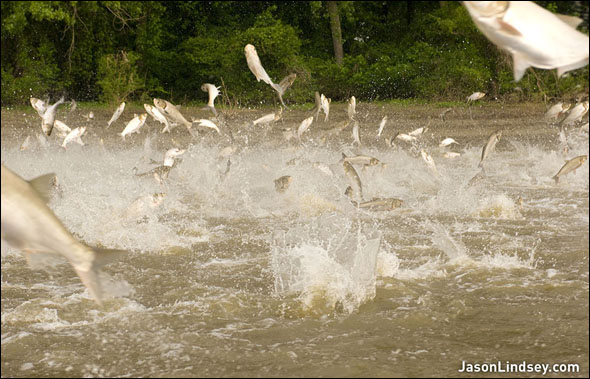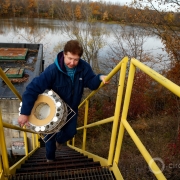Advance of the Invader: Asian Carp Continue March to Northern Waters
Live carp have been found in North Dakota and past the electric barriers in Chicago. As the carp push forward, Michigan and other Great Lakes states are once again asking the U.S. Supreme Court to speed up action to stop the advance of the invader.

By Codi Yeager
Circle of Blue
A silver carp was caught in North Dakota’s James River in October, marking the first confirmed catch in that state, the Star Tribune of Minneapolis reported. Individual fish also have turned up over the past year in Minnesota’s St. Croix River and, alarmingly, past deterrent barriers in Chicago that are meant to keep large populations from reaching the Great Lakes.
“The thing about eDNA is that any one hit doesn’t necessarily mean that much.”
— Duane Chapman
Research Fisheries Biologist
USGS Columbia Environmental Research Center
If the carp reach the Great Lakes — there are two species, the silver and the bighead, that are native to Eurasia and which first escaped from aquaculture facilities in the southern United States in the 1970s — there are concerns about the harm they would do to the $US 7 billion sport-fishing industry. These fish have a voracious appetite for plankton, the basis of most aquatic food chains, and can eat so much that they starve competing native fish. Asian carp are also known to jump out of the water at the sound of boat engines and can injure boaters if they land in a vessel.
Where The Carp Are Now
“We found one bighead in the Chicago area on the wrong side of the barrier, and there has been carp DNA from a few of a great number of samples from Chicago-area waterways,” Duane Chapman, a research fisheries biologist at the U.S. Geological Survey Columbia Environmental Research Center, told Circle of Blue. Environmental DNA analysis of one sample from Lake Michigan came back positive for carp, though Chapman is cautious about interpreting the result. “The thing about eDNA is that any one hit doesn’t necessarily mean that much.”
In a paper published last spring, researchers from Notre Dame University and The Nature Conservancy — who pioneered the use of eDNA to test for Asian carp in 2009 and 2010 — acknowledge that the method does not give information about the number of fish present in a given location. Positive results only suggest that at least one fish has been in the area. The method is useful, however, because it allows researchers to detect very low numbers of carp, whereas traditional netting or electroshock methods only detect carp when they have reached moderate abundance.
Detecting small numbers of carp is important because it gives management officials time to stop the fish from breeding and establishing a population.
“People have a feeling that it only takes two fish, but, really, you have to have a certain number of fish in the right place at the right time to spawn,” Chapman said. This is why, he explained, carp invasion of the Great Lakes is not inevitable, even if a few fish get in.
However, finding a few fish often means there will be more.
“We are taking every legal action we can. We are pressing on every front.”
— Joy Yearout
Spokesperson
Michigan Attorney General Shuette
“In places where they have established in large numbers, they will show up off and on for about 10 years, until there are enough adults to have a spawn,” Tim Schlagenhaft of the Minnesota Department of Natural Resources told Circle of Blue. “Then the population increases dramatically, which is what we are concerned about. We don’t know how many might be here.”
States Again Turn to Supreme Court
Some Great Lakes states are not willing to take the risk. Michigan, Minnesota, Ohio, Pennsylvania, and Wisconsin requested an appeal with the U.S. Supreme Court in October. The request came after the 7th Circuit U.S. Court of Appeals in Chicago refused to grant an injunction requiring the U.S. Army Corps of Engineers to install preventative nets and speed up a study on permanently separating the Great Lakes from the Mississippi River Basin.
The Supreme Court denied two previous requests to take the Asian carp case, but this time is different, according to Joy Yearout, spokeswoman for Michigan Attorney General Bill Shuette. While previous requests have attempted to bypass the district and circuit courts — claiming the case was a dispute between states — the current petition asks for an appeal decision in the lawsuit against the Army Corps of Engineers and the Chicago Water District.
Michigan is also pursuing avenues to stop the carp in Congress.
“There is legislation in both the House and the Senate that could potentially make the same impact as the lawsuit,” Yearout told Circle of Blue. “We are taking every legal action we can. We are pressing on every front.”
Will the Carp Get In?
It is likely that some carp are already in the Great Lakes, as the eDNA suggests. Flooding events, pond escapes, and the transportation of live bait for fishing are all avenues by which the carp could travel.
“They can be transported directly by human beings, and that is a high risk,” Chapman said. “It is hard to believe that some carp have not made it into the Great Lakes.”
“They have never been here, so we don’t know if the waters are suitable for them, but their native range in Asia goes well into the same latitudes as Canada.”
— Tim Schlagenhaft
Minnesota Dept. of Natural Resources
In river systems, like those in Minnesota, it is even more likely that some carp will make it into new territory.
“They are strong swimmers, and it will be difficult to prevent them from getting into our waters entirely,” said Schlagenhaft. “We are looking at if they do increase in number and establish a population, what can we do to slow them down? What can we do to manage them? We are trying to address the problem before it gets out of hand.”
Environmental Constraints (Or Lack Thereof)
The good news is that Asian carp require specific types of streams and rivers to spawn and create surviving young, Chapman said. The bad news is that at least one of the Great Lakes meets these requirements.
“Our research found that bighead and silver carp would mature in Lake Erie and would find places to spawn and raise young successfully, if they get into the lake in substantial numbers,” Chapman said. This study is set to publish in the Journal of Great Lakes Research.
In colder, northern lakes, the carp may run into problems.
“There is nothing in the cold water to kill them, but the question is whether or not they can reproduce,” Chapman said, since young develop faster under warmer conditions and require enough warm days to spawn and mature.
Schlagenhaft agreed that how the carp behave in northern waters remains unknown. “They have never been here, so we don’t know if the waters are suitable for them, but their native range in Asia goes well into the same latitudes as Canada.”
Codi Yeager is a journalism student at West Virginia University and a Morgantown-based reporter for Circle of Blue.
Sources: Star Tribune; University of Notre Dame Center for Aquatic Conservation; United States Geological Survey
A news correspondent for Circle of Blue based out of Hawaii. She writes The Stream, Circle of Blue’s daily digest of international water news trends. Her interests include food security, ecology and the Great Lakes.
Contact Codi Kozacek









Leave a Reply
Want to join the discussion?Feel free to contribute!